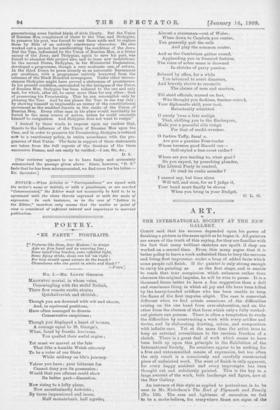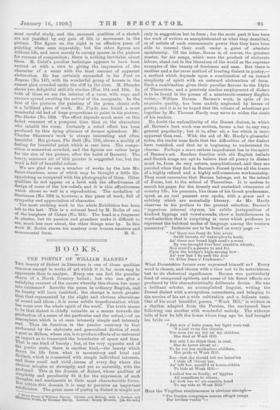ART.
THE INTERNATIONAL SOCIETY AT THE NEW GALLERY.
Cowl: said that his success depended upon his power of finishing a picture in the same spirit as he began it. All painters are aware of the truth of this saying, for they are familiar with the fact that many brilliant sketches are spoilt if they are worked on a second time. From this many argue that it is better policy to leave a work unfinished than to bury the nervous and living first impression under a heap of added facts which some people call finish. If filo painter is only strong enough to carry his painting as as the first stage, and is unable to reach that true completion which enhances rather than obscures the original impulse, he will be wise to pause. It is a thousand times better to have a flue suggestion than a dull and wearisome thing in which all joy and life have been killed by the heavy-handed artificer who has been unable to keep the flame of the first impulse alight. The case is somewhat different when we find artists conscious of the difficulties arising on the one hand from over-elaboration, and on the other from the absence of that force which only a fully worked- out picture can possess. There is often a temptation to evade the difficulties by constructing a work with every artifice and device, and by elaborating drawing, colour, and composition with infinite care. Yet at the same time the artist tries to keep an external resemblance to the careless freedom of a sketch. There is a great deal of work which seems to have been built up upon this principle in the Exhibition of the International Society. Its members appear to be seeking for a free and untrammelled means of expression, but too often the only result is a consciously and carefully constructed piece of unfinished work. The want of finish is only apparent, for every happy accident and every impromptu has been thought out and sedulously painted. This is the key to a large amount of the work, both landscape and figure, now at the New Gallery.
An instance of this style as applied to portraiture is to be seen in Mr. Nicholson's The Earl of Plymouth and Family (No. 156). The ease and lightness of execution we feel to be a make-believe, for everywhere there are signs of the most careful study, and the assumed qualities of a sketch are not justified by any gain of life or movement in the picture. The figure on the right is an effective piece of painting when seen separately, but the other figures are without life, and seem merely to occupy spaces in the picture for reasons of composition ; there is nothing inevitable about them. M. Octet's peculiar technique appears to have been arrived at with a view to giving the impression of the character of a scene with the least amount of apparent elaboration. He has certainly succeeded in his .Pont en Boyans (No. 147), with its wonderful group of houses in the sunset glow crowded under the cliff by the river. M. Blanche shows two delightful still-life studies (Nos. 184 and 194). In both of these we see the interior of a room with cups and saucers spread awaiting the arrival of the occupants. In the first of the pictures the painting of the green chintz sofa is a brilliant piece of work. Mr. Pryde has found a most wonderful old bed of huge proportions to paint in his picture, The Doctor (No. 1895. The effect depends much more on this faded remnant of a pompous time than on the characters who inhabit the room. Certainly a weird effect has been Produced by this dying glimmer of former splendour. Mr. Charles Shannon's work is always interesting and often beautiful. His picture, The Bath (No. 159), shows a quality of feeling for beautiful paint which is rare here. The compo- sition is somewhat crowded, and the figures are rather large for the size of the picture, after the habit of Rossetti. The heavy, sensuous air of this painter is suggested too, but the Work is full of beautiful colour.
We are glad to see a number of works by the late Mr. Saint-Gaudens, some of which may be thought a little dis- appointing as compared with the photographs of them. Other qualities do not appear on a level with the effectiveness of design of some of the low-reliefs, and it is this effectiveness Which shows so well in a reproduction. The medallion of Stevenson (No. 39.9) is, however, a fine piece of work, full of sympathy and appreciation of character.
The most striking work in the whole Exhibition has been left to the last. This is a colossal head by M. Rodin of one of the burghers of Calais (No. 355). The head is a fragment ul plaster, but its passion and grandeur make it difficult to see, much less care about, the other things near by. In this work M. Rodin shows his mastery over human emotion and





































 Previous page
Previous page